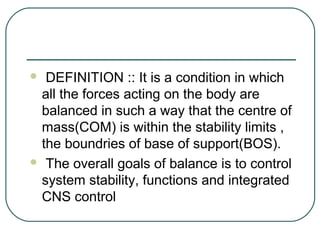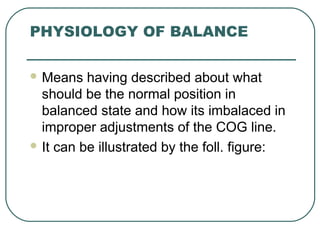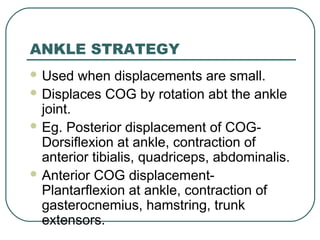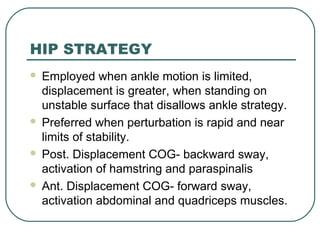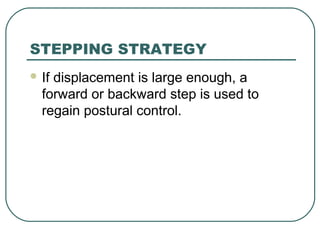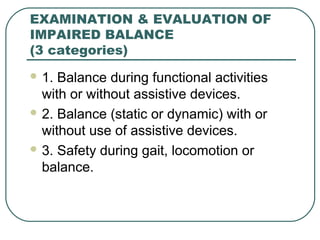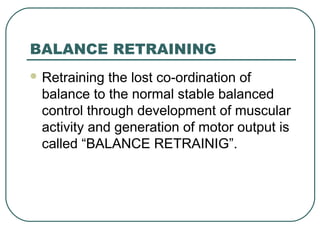Balance
- 1. BALANCE
- 2. ïŽ DEFINITION :: It is a condition in which all the forces acting on the body are balanced in such a way that the centre of mass(COM) is within the stability limits , the boundries of base of support(BOS). ïŽ The overall goals of balance is to control system stability, functions and integrated CNS control
- 3. Postural Stability ïŽ Ability to maintain the COG within the stability limits. ïŽ Normal anterior/posterior sway-12 degrees from most posterior-anterior position. ïŽ Lateral sway-16 degrees from side to side. ïŽ If sway exceeds boundaries, compensation is employed to regain balance. A smaller envelope is created and tolerated.
- 4. PHYSIOLOGY OF BALANCE ïŽ Means having described about what should be the normal position in balanced state and how its imbalaced in improper adjustments of the COG line. ïŽ It can be illustrated by the foll. figure:
- 5. CONTRIBUTION OF SENSORY SYSTEM ïŽ Sensory system has a major contribution in the co-ordination of balance. ïŽ Three pairs of the sensory system have a dominating part in the same. They are ïŽ VISUAL ïŽ SOMATOSENSORY ïŽ VESTIBULAR
- 6. VISUAL & VESTIBULAR NEUROPHYSIOLOGY ïŽ VISUAL NEUROPHYSIOLOGY provides information regarding the position of the head, related to the environment and orients the head to maintain the gaze level. ïŽ VESTIBULAR NEUROPHYSIOLOGY provides information regarding the orientation of head in space & acceleration.
- 7. SOMATOSENSORY ïŽ Free Nerve Endings ïŽ Ruffini Endings ïŽ Paciniform Corpuscles ïŽ Golgi-Mazzoni Corpuscles ïŽ Golgi Ligament Endings ïŽ Muscle Spindles
- 8. PROCESSING SENSORY INFORMATION ïŽ Itmeans how all the 3 components i.e VISUAL SOMATOSENSORY & VESTIBULAR of the sensory system processes in order and from which regions to gain proper motor output.
- 9. COMPONENTS OF BALANCE ïŽ There are 3 chief components: ïŽ (1) sensory system ïŽ (2) musculoskeletal system ïŽ (3) vestibular ï Sensory System: As described above ï MSS: Helps to maintain the normal balance by various processes of the system such as muscle contractions, relaxations etc. ï Vestibular System: It provides the info abt the orientation of head in space & acceleration.
- 10. BIOMECHANICAL COMPONENTS ïŽ Here3 main strategies used are ANKLE, HIP & STEPPING PHENOMENA
- 11. ANKLE STRATEGY ïŽ Used when displacements are small. ïŽ Displaces COG by rotation abt the ankle joint. ïŽ Eg. Posterior displacement of COG- Dorsiflexion at ankle, contraction of anterior tibialis, quadriceps, abdominalis. ïŽ Anterior COG displacement- Plantarflexion at ankle, contraction of gasterocnemius, hamstring, trunk extensors.
- 12. HIP STRATEGY ïŽ Employed when ankle motion is limited, displacement is greater, when standing on unstable surface that disallows ankle strategy. ïŽ Preferred when perturbation is rapid and near limits of stability. ïŽ Post. Displacement COG- backward sway, activation of hamstring and paraspinalis ïŽ Ant. Displacement COG- forward sway, activation abdominal and quadriceps muscles.
- 13. STEPPING STRATEGY ïŽ Ifdisplacement is large enough, a forward or backward step is used to regain postural control.
- 14. CAUSES FOR IMPAIRED BALANCE ïŽ Patientsmay develop balance deficits coz of impaired sensory input from joint mechanoreceptors and altered muscle spindle input. This particularly occurs in weight bearing joints.
- 15. CAUSES FOR IMPAIRED BALANCE ïŽ Injury or disease of eyes, inner ear, peripheral receptors, spinal cord, cerebellum, basal ganglia, cerebrum etc. ïŽ Injury or damage to knee, ankle, hip and back ïŽ CVAs, tumors, visual field loss ïŽ Age
- 16. EXAMINATION & EVALUATION OF IMPAIRED BALANCE (3 categories) ïŽ 1. Balance during functional activities with or without assistive devices. ïŽ 2. Balance (static or dynamic) with or without use of assistive devices. ïŽ 3. Safety during gait, locomotion or balance.
- 17. EXAMINATION & EVALUATION OF IMPAIRED BALANCE ïŽ Standing with eyes open- Fixed platform ïŽ Standing blindfolded- Fixed platform ïŽ Sway-refernced vision with fixed support ïŽ Normal vision with sway-referenced support ïŽ Absent vision with sway-referenced support ïŽ Sway referenced vision and support
- 18. ACTIVITIES OF TREATING IMPAIRED BALANCE ïŽ Impaired balance can be treated by foll ways: ïŽ 1. Gradual intervention (mode) ïŽ 2. Posture for COG control ïŽ 3. Movement
- 19. MODE-GRADUATED INTERVENTION ïŽ Begin with weight shifts on a stable surface. ïŽ Gradually increases sway ïŽ Increase surface challenges (mini-tramp)
- 20. POSTURE ïŽ Often includes âcore stability trainingâ to improve COG control and sense of trunk posture. ïŽ Begin in supine or seated position. ïŽ Over sessions, use a variety of arm positions, unstable surfaces, single leg stances etc.
- 21. MOVEMENT ïŽ Adding movement patterns to acquired stable static postures increase balance challenge. ïŽ Add ant./post sway to increase stability limits. ïŽ Trunk rotations and altered head positions alter vestibular input. ïŽ PNF Techniques during trunk rotation. ïŽ Stepping back/forward assists in re- stabilization exercises.
- 22. PRECAUTIONS FOR IMBALANCE ïŽ Pain should not occur during exercises. ïŽ Donot initiate exercises at maximum level. ïŽ Avoid uncontrolled, ballistic movements as they compromise safety & effectiveness. ïŽ Avoid exercises that creates stress on back. ïŽ Discontinues exercises if patient experiences pain, dizziness or unusual shortness of breath. ïŽ Eliminate obstacles or unsafe instruments from exercise area.
- 23. CONTAINDICATONS ïŽ Persons who are inheritently in balance- challenged positions. ïŽ Pain or muscle pain. ïŽ Inflammatory neuromuscular disease. ïŽ Severe cardio-pulmonary diseases.
- 24. TYPES OF IMPAIRMENTS ïŽ Mainly 4 types- ïŽ 1. Musculoskeletal ïŽ 2. Neuromuscular ïŽ 3. Cardiovascular or Pulmonary ïŽ 4. Integumentary
- 25. ïŽ MUSCULOSKLETAL- ïž Pain, muscle weakness, Jt. Hypermobility, Faulty posture, muscle imbalances, limited ROM etc. âĒ NEUROMUSCULAR- ïž Pain, impaired balance, delayed motor development, ineffective, abnormal tone. âĒ CARDIOVASCULAR- ïž âed aerobic capacity, impaired circulation, pain with sustained physical activity (intermittent claudication). âĒ INTEGUMENTARY- ïž Skin hypomobility.
- 26. BALANCE RETRAINING ïŽ Retraining the lost co-ordination of balance to the normal stable balanced control through development of muscular activity and generation of motor output is called âBALANCE RETRAINIGâ.


